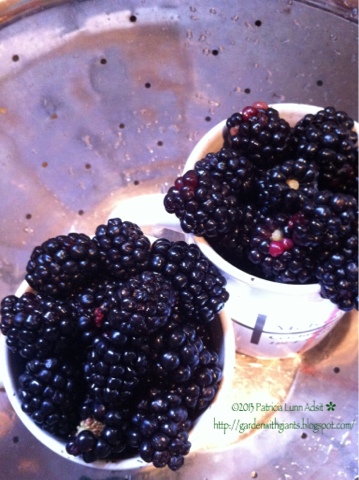What is Summer? Earlier this year, the Grow Write Guild asked "what plant encapsulates the essence of summer" for you? That's easy! For me, nothing shouts "it's Summertime!" like the blackberry!
I see Summer, oozing from every ripe berry, which makes the colorful transition from the rich red of my ruby birthstone to the shiny ebony-black that announces the time for enjoying has arrived. I taste sweetness and warmth in every bite I pop in my mouth...straight from the bush or retrieved from my cup while still standing in the berry patch...who can bear to postpose gratification until the kitchen sink? I hear the long-ago peels of childhood laughter at finding the first arching canes, draped along the fence row on the farm, loaded with prizes for the picking. I feel the pricks and the scratches as the thorns try to keep me from the best rewards, deep within the bush...no matter; tis but a fleeting sensation, never deterring me for more than a moment.
When Mother Nature puts the "Ripe Now!" sign on the blackberries, I know that it is truly Summer!
Some things have changed with the years and across the miles. I no longer need to drive to the family farm for the annual outing to gather my favorite fruit; I have my own Berry Patch in our Way Back Garden. While I miss the comfort of connecting with cousins over common ground, I am thoroughly enjoying the convenience of having my very own U Pick 'Em.
Nor do I always need battle thorns, as we have planted two thornless varieties:
Arapaho and
Navajo. From North Carolina Cooperative Extension's online publication,
Growing Blackberries in North Carolina:
The (Arapaho and Navajo) cultivars are from the University of Arkansas breeding program. These cultivars, named in honor of Native American tribes, do well in North Carolina...
Arapaho...
Released by the University of Arkansas in 1993.
Very erect, thornless, and suckers freely. Ripens 2 weeks earlier than Navaho, but has a short picking period. Fruit: good quality, medium size, short, conic, glossy black, firm, stores and ships better than most other blackberries; modest seed size. Up to this time has been resistant to double blossom in North Carolina, and orange rust has also seldom been observed.
Navaho...
Released by the University of Arkansas in 1988.
Erect, thornless. Medium size berries of good quality; moderate to high productivity. Stores well, suitable for air transport. Susceptible to orange rust. Has not had a problem with double blossom in North Carolina up to this time.
Still, we continue to have the occasion to yell "ouch," as we also have several outcroppings of wild...and very thorny...bushes. We keep the wild ones so the birds will have their own...and hopefully leave "ours" for us, but can't resist taste-testing the tiny berries.
Growing blackberries is so easy...truly! Select a spot that gets full sun (8 hours daily), and where the soil tests to 6.0-6.5 pH. (We've added lime to the Berry Patch quadrant of the Way Back Garden per our 2011 Soil test recommendations to correct the high-acid 5.3 pH soil...great for blueberries; not "sweet" enough for blackberries and grapes.) In the late winter, I prune off any dead branches and spray with dormant oil, just like I do the Orchard and the Rose Garden...twice over a two-month period if the conditions are right...before any bud breaks. Then in the early spring, I feed each bush with 1/2 cup 10-10-10 and add mushroom compost in a collar around the base, just as the bushes begin to flower.
Since both of our varieties (Arapaho and Navajo) are erect or 'upright' blackberry cultivars, we have them planted 6 feet apart (for good air circulation) and supported by a two-wire trellis system; I use clothespins to help train the growing branches to the wires...when they put on fruit, those branches will get heavy. And that's it...just bide your time from early May (when the bushes flower) to early July (when the first fruits begin to ripen...and then enjoy the fruits of your labors!
And oh the wonderful things you can do with blackberries! How about a juicy cobbler? Yum! What about blackberry preserves? Most people make jelly or jam; me? I'm a fan of the seeds, if you can believe that, so I don't feel the need to strain them out of the finished product. But my grandfather did love a Jam Cake, made with blackberry jam...no seeds, please!
I had also hoped to have some blackberries to freeze, to enjoy my favorite fruit come next January. Alas, the season ended much too soon. Only managed a couple of quarts for the freezer. Sigh. Still this is only the second year for fruiting of these bushes, so I dream of heavier yields in the years to come.
Two last chores after the harvest and before we say goodbye to the blackberries for another year:
(1) fertilizing with another 1/2 cup of 10-10-10, to encourage good growth of next year's fruiting canes; and (2) removing the 'spent' canes. You see, blackberries are produced on one-year-old canes, so the canes that produced so many lovely, juicy blackberries for us this year are done...spent...and must be lopped-off at ground level. Additionally, all those new canes need to be topped-off about a foot from the end of the new growth, to encourage the new canes to branch out with more new growth before frost.
All of these cuttings go into the yard waste toter and down to the street, off our property...not into the compost: too much opportunity for overwintering of insects and/or disease(s), so why take the chance?
Yes, the blackberry season is short and sweet, and I'm already anticipating breaking out one of those quarts of berries I have socked away in the freezer. But, no...must resist temptation for delayed gratification.
A taste of Summer in the dead of Winter. The essence of a good life.







